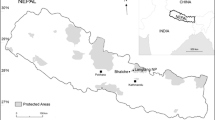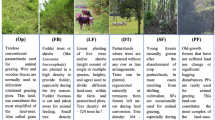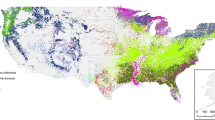Abstract
This study explores the relationships between an increase in tree cover area (i.e., natural and planted-tree land covers) and changes in forest carbon storage and the potential of a landscape to provide habitat for native floristic biodiversity. Four areas experiencing an increase in tree cover were analyzed. We developed a metric estimating the potential to support native biodiversity based on tree cover type (plantation or natural forests) and the landscape pattern of natural and anthropogenic land covers. We used published estimates for forest and plantation carbon stocks for each region. Focus regions in northwestern Costa Rica, northern Vietnam, southern Chile and highland Ecuador all showed an increase in tree cover area of 390 %, 260 %, 123 % and 418 %, respectively. Landscapes experiencing increases in natural secondary forest also experienced an increase in carbon stored above and below ground, and in the potential to support native floristic biodiversity. Study landscapes in Chile and Ecuador experiencing an expansion of exotic plantations saw their carbon stock decrease along with their potential to support native floristic biodiversity. This study shows that an increase in forest area does not necessarily imply an increased provision of ecosystem services when landscapes are reforesting with monoculture plantations of exotic tree species. Changes in the support of native biodiversity and the carbon stored in pulp rotation plantations, along with other ecosystem services, should be fully considered before implementing reforestation projects.


Similar content being viewed by others
References
Angelsen A, Brockhaus M, Kanninen M, Sills E, Sunderlin WD, Wertz-Kanounnikoff S (eds) (2009) Realising REDD+: national strategy and policy options. CIFOR, Bogor, Indonesia
Armstrong AJ, van Hensbergen HJ, Scott DF, Milton SJ (1996) Are pine plantations “inhospitable seas” around remnant native habitat within south-western Cape forestry areas? S Afr For J 176:1–10
Bauhus J, van der Meer P, Kanninen M (eds) (2010) Ecosystem goods and services from plantation forests. The Earthscan Forest Library, London
Bodmer RE, Eisenberg JF, Redford KH (1997) Hunting and the likelihood of extinction of Amazonian mammals. Conserv Biol 11:460–466
Bremer L, Farley K (2010) Does plantation forestry restore biodiversity or create green deserts? A synthesis of the effects of land-use transitions on plant species richness. Biodivers Conserv 19(14):3893–3915
Brockerhoff EG, Jactel H, Parrotta JA, Quine CP, Sayer J (2008) Plantation forests and biodiversity: oxymoron or opportunity? Biodivers Conserv 17:925–951
Buytaert W, Iñiguez V, De Bièvrec B (2007) The effects of afforestation and cultivation on water yield in the Andean páramo. For Ecol Manag 251:22–30
Chapela IH, Osher LJ, Horton TR, Henn MR (2001) Ectomycorrhizal fungi introduced with exotic pine plantations induce soil carbon depletion. Soil Biol Biochem 33(12–13):1733–1740
Chazdon R (2003) Tropical forest recovery: legacies of human impact and natural disturbances. Perspect Plant Ecol Evol Syst 6(1):51–71
Chazdon RL, Peres CA, Dent D, Sheil D, Lugo AE, Lamb D, Stork NE, Miller S (2009) Assessing the potential for species conservation in tropical. Conserv Biol 23:1406–1407
Coulter FA (1959) Density of Pinus radiate logs, N Z J For 8(1):143–147
Cumming G, George A (2009) Historical influences dominate the composition of regenerating plant communities in abandoned citrus groves in north-central Florida. Landscape Ecol 24:957–970
Daniels AE (2006) Incorporating domain knowledge and spatial relationships into land cover classifications: a rule based approach. Int J Remote Sens 27:2949–2975
Daniels AE (2010) Forest expansion in northwest Costa Rica: conjuncture of the global market, land use intensification and forest protection. In: Nagendra H, Southworth J (eds) Reforesting landscapes: linking pattern and process. Springer, New York, pp 227–252
Daniels AE, Cumming GS (2008) Conservation or conversion? Understanding wetland change in northwest Costa Rica. Ecol Appl 18:49–63
De Koninck R (1999) Deforestation in Vietnam. International Development Research Center, Ottawa
Dent D (2010) Defining the conservation value of secondary tropical forests. Anim Conserv 13:14–15
Dent D, Wright S (2009) The future of tropical species in secondary forests: a quantitative review. Biol Conserv 142:2833–2843
Echeverría C, Newton AC, Lara A, Rey-Benayas JM, Coomes DA (2007) Impacts of forest fragmentation on species composition and forest structure in the temperate landscape of southern Chile. Glob Ecol Biogeogr 16:426–439
Estades CF, Temple SA (1999) Deciduous-forest bird communities in a fragmented landscape dominated by exotic pine plantations. Ecol Appl 9:573–585
FAO (2010) Global forest resources assessment 2010. In: Main report. Food and Agriculture Organization of the United Nations, Rome
Farley KA (2007) Grasslands to tree plantations: forest transition in the Andes of Ecuador. Ann Assoc Am Geogr 97:755–771
Farley KA, Kelly EF, Hofstede R (2004) Soil organic carbon and water retention after conversion of grasslands to pine plantations in the Ecuadorian Andes. Ecosystems 7:729–739
Felton A, Knight E, Wood J, Zammit C, Lindenmayer D (2010) A meta-analysis of fauna and flora species richness and abundance in plantations and pasture lands. Biol Conserv 143:545–554
Gayoso J, Schlegel B (2003) Estudio de línea de base carbono: Carbono en bosques nativos, matorrales y praderas de la décima región de Chile. Universidad Austral de Chile, Valdivia
Gonzalez P, Lara A, Gayoso J, Neira E, Romero P, Sotomayor L (2005) Comparison of three methods to project future baseline carbon emissions in temperate rainforest, Curiñanco, Chile. In: Topical report. U.S. Department of Energy, National Energy Technology Laboratory, Morgantown
Grainger A, Boucher DH, Frumhoff PC, Laurance WF, Lovejoy T, McNeely J, Niekisch M, Raven P, Sodhi NS, Venter O, Pimm SL (2009) Biodiversity and REDD at Copenhagen. Curr Biol 19(21):974–976
Granda P (2005) Carbon Sink Plantations in the Ecuadorian Andes: impacts of the Dutch FACE-PROFAFOR monoculture tree plantations’ project on indigenous and peasant communities. WRM series on tree plantations no. 1. WRM, Montevideo
Guariguata M, Chazdon R, Denslow J, Dupuy J, Anderson L (1997) Structure and floristics of secondary and old-growth forest stands in lowland Costa Rica. Plant Ecol 29(1):107–120
Gullison R, Frumhoff P, Canadell J, Field C, Nepstad D, Hayhoe K, Avissar R, Curran L, Friedlingstein P, Jones C, Nobre C (2007) Tropical forests and climate policy. Science 316:985–986
Guo LB, Gifford RM (2002) Soil carbon stocks and land use change: a meta analysis. Glob Change Biol 8:345–360
Hansen M, DeFries R, Townshend J, Carroll M, Dimiceli C, Sohlberg R (2003) Global percent tree cover at a spatial resolution of 500 meters: first results of the MODIS vegetation continuous fields algorithm. Earth Interact 7:1–15
Hernández-Stefanoni JL, Dupuy JM, Tun-Dzul F, May-Pat F (2011) Influence of landscape structure and stand age on species density and biomass of a tropical dry forest across spatial scales. Landscape Ecol 26:355–370
Hofstede R, Aquirre N (1999) Biomass and carbon dynamics in relation to activities forest in the Sierra of Ecuador. In: Medina G, Mena P, Josse C (eds) (1999) Páramo as space of atmospheric carbon mitigation (páramo como espacio de mitigación de carbono atmosférico) Serie Páramo, 1. GTP/Abya Yala, Quito
Hofstede R, Groenendijk J, Coppus R, Fehse J, Sevink J (2002) Impact of pine plantations on soils and vegetation in the Ecuadorian High Andes. Mt Res Dev 22(2):159–167
Houghton R, Hackler J (1999) Emissions of carbon from forestry and land-use change in tropical Asia. Glob Change Biol 5:481–492
INFOR (1987) Especies forestales exóticas de interés económico para Chile. Corporación de Fomento a la Producción, Santiago
INFOR (2001) Estadísticas forestales 2000. Instituto Forestal. Boletín Estadístico Nº 30. Santiago
Jackson RB, Banner JL, Jobbágy EG, Pockman WT, Walls DH (2002) Ecosystem carbon loss with woody plant invasion of grasslands. Nature 418:623–626
Kennard DK (2002) Secondary forest succession in a tropical dry forest: patterns of development across a 50-year chronosequence in lowland Bolivia. J Trop Ecol 18:53–66
Lambin E, Meyfroidt P (2010) Land use transitions: socio-ecological feedback versus socio-economic change. Land Use Policy 27:108–118
Liao CZ, Luo YQ, Fang CM, Li B (2010) Ecosystem carbon stock influenced by plantation practice: implications for planting forests as a measure of climate change mitigation. PLoS ONE 5:e1086
Lindenmayer D, Wood JT, Cunningham RB, Crane M, MacGregor C, Michael D, Montague-Drake R (2009) Experimental evidence of the effects of a changed matrix on conserving biodiversity within patches of native forest in an industrial plantation landscape. Landscape Ecol 24:1091–1103
Lohmann L, Hällström N, Nordberg O, Österbergh R (2006) Carbon trading: a critical conversation on climate change, privatisation and power. Dev Dialog 48
Lomolino MV (2000) A call for a new paradigm of island biogeography. Glob Ecol Biogeogr 9(1):1–6
Lugo AE (2002) Can we manage tropical landscapes?—an answer from the Caribbean perspective. Landscape Ecol 17:601–615
Matus FJ, Lusk CH, Maire CR (2008) Effects of soil texture, carbon input rates, and litter quality on free organic matter and nitrogen mineralization in chilean rain forest and agricultural soils. Commun Soil Sci Plant Anal 39:187–201
MEA (2005) Ecosystems and human well-being: synthesis. In: Millenium ecosystem assessment. Island Press, Washington, DC
Meyfroidt P, Lambin EF (2008a) The causes of the reforestation in Vietnam. Land Use Policy 25:182–197
Meyfroidt P, Lambin EF (2008b) Forest transition in Vietnam and its environmental impacts. Glob Change Biol 106(38):1319–1336
Meyfroidt P, Lambin EF (2011) Global forest transition: prospects for an end to deforestation. Annu Rev Environ Resour 36:343–371
Moser G, Leuschner C, Hertel D, Graefe S, Soethe N, Iost S (2011) Elevation effects on the carbon budget of tropical mountain forests (S Ecuador): the role of the belowground compartment. Glob Change Biol 17:2211–2226
Nilsson S, Schopfhauser W (1995) The carbon-sequestration potential of a global afforestation program. Clim Change 30:267–293
Norden N, Chazdon R, Chao A, Jiang Y, Vilchez-Alvarado B (2009) Resilience of tropical rain forests: tree community reassembly in secondary forests. Ecol Lett 12:385–394
Nunez-Iturri G, Olsson O, Howe H (2008) Hunting reduces recruitment of primate-dispersed trees in Amazonian Peru. Biol Conserv 12(5):1536–1546
Palm CA, Houghton RA, Melillo JM, Skole DL (1986) Atmospheric carbon dioxide from deforestation in Southeast Asia. Biotropica 18(3):177–188
Paritsis J, Aizen MA (2008) Effects of exotic conifer plantations on the biodiversity of understory plants, epigeal beetles and birds in Nothofagus dombeyi forests. For Ecol Manag 255(5–6):1575–1583
Paul KI, Polglase PJ, Nyakuengama JG, Khanna PK (2002) Change in soil carbon following afforestation. For Ecol Manag 168:241–257
Phillips OL, Malhi Y, Higuchi N, Laurance WF, Núñez PV, Vásquez RM, Laurance SG, Ferreira LV, Stern M, Brown S, Grace J (1998) Changes in carbon balance of tropical forests: evidence from long-term plots. Science 282:439–441
Rhoades CC, Eckert GE, Coleman DC (2000) Soil carbon differences among forest, agriculture, and secondary vegetation in lower montane Ecuador. Ecol Appl 10:497–505
Sayer J, Chokkalingam U, Poulsen J (2004) The restoration of forest biodiversity and ecological values. For Ecol Manag 201:3–11
Silver W, Ostertag R, Lugo A (2000) The potential for carbon sequestration through reforestation of abandoned tropical agricultural and pasture lands. Restor Ecol 8(4):394–407
Sklenár P, Ramsay PM (2001) Diversity of zonal páramo plant communities in Ecuador. Divers Distrib 7:113–124
Strassburg B, Kelly A, Balmford A, Davies R, Gibbs H, Lovett A, Miles L, Orme CD, Price J, Turner R, Rodrigues A (2010) Global congruence of carbon storage and biodiversity in terrestrial ecosystems. Conserv Lett 3:98–105
Tomberlin D, Buongiorno J (2001) Timber plantations, timber supply, and forest conservation. In: Palo M, Uusivuori J, Mery G (eds) World forests, markets, and polices world forests volume III. Kluwer Academic Publishers, Dordrecht, pp 85–94
Totten M, Pandya S, Janson-Smith T (2003) Biodiversity, climate, and the Kyoto Protocol: risks and opportunities. Front Ecol Environ 1(5):262–270
Turner J, Lambert M (2000) Change in organic carbon in forest plantation soils in eastern Australia. For Ecol Manag 133(3):231–247
Turner MG, Gardner RH, O’Neill RV (2001) Landscape ecology in theory and practice: pattern and process. Springer, New York
Van Holt T (2009) Influence of twenty years of land use land cover change on the nearshore fisheries in southern Chile. Dissertation. University of Florida, Gainesville
Vanacker V, Balthazar V, Molina A (2011) Anthropogenic activity triggering landslides in densely populated mountain areas. In: Proceedings of the second world landslide forum, Rome, Italy
Acknowledgments
This research was funded by the Belgian Science Policy, Research Program for Earth Observation Stereo II, contract SR/00/133, as part of the FOMO project (remote sensing of the forest transition and its ecosystem impacts in mountain environments). The authors would like to thank Patrick Meyfroidt, Marie Guns and Veerle Vanacker for their valuable information relating to Vietnam and Ecuador, and three anonymous reviewers who helped improve this manuscript.
Author information
Authors and Affiliations
Corresponding author
Electronic supplementary material
Below is the link to the electronic supplementary material.
Rights and permissions
About this article
Cite this article
Hall, J.M., Van Holt, T., Daniels, A.E. et al. Trade-offs between tree cover, carbon storage and floristic biodiversity in reforesting landscapes. Landscape Ecol 27, 1135–1147 (2012). https://doi.org/10.1007/s10980-012-9755-y
Received:
Accepted:
Published:
Issue Date:
DOI: https://doi.org/10.1007/s10980-012-9755-y




